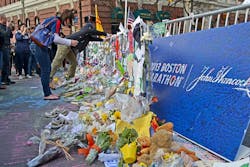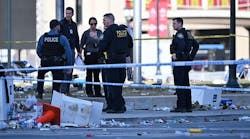Last week, a jury found Dzhokhar Tsarnaev guilty of all 30 counts he faced for his role in the Boston Marathon bombing. As the trial gets ready to head to penalty phase, Boston is preparing to mark the two year anniversary of the terror attack, which killed three people and injured more than 260 others.
One person who was on the frontlines that day was Bonnie Michelman, director of police, security and outside services at Massachusetts General Hospital, who recently recounted her memories of the aftermath of the bombing at last year’s Secured Cities conference in Baltimore. According to Michelman, even a normal Monday at the hospital, which has 26,000 employees and 1,000 patient beds, can be “completely chaotic,” but the day of the bombing she described as being “sheer chaos” for her and the rest of the security and clinical staff.
“It was the most horrific scene. We thought we were in a war zone,” she said.
Massachusetts General received the first patient from the blast at 3:04 p.m. on the day of bombing, which was less than 15 minutes after the bomb exploded near the finish line of the marathon. The hospital would end up treating 39 people who were injured in the bombing, the most of any hospital in the area. Soon after the first patients were transported to the hospital, Michelman said that thousands of people began to make their way through their entrances including media, family members of the victims, law enforcement and staff.
Adding to the hysteria, there were reports in the immediate aftermath of the bombing that there other improvised explosive devices in the area that had either detonated or had been planted. Those reports later proved to be false, but it didn’t help the hospital staff in trying to keep the mood calm. “We were worried that we were a target,” said Michelman.
Moving into the night after the bombing and the following day, Michelman said there were several areas she and her team had to focus on including; collaborating with outside law enforcement agencies; identification of patients and reuniting them with their families; collection and preservation of potential evidence; and mutual aid issues.
Michelman said that one of lessons other security practitioners should take away from this and other events is that they need to drill as if they’re not going to receive mutual aid. She also emphasized the need to communicate with everyone involved – staff, patients, family members, etc. – to ensure that rumors and falsehoods don’t run amok.
Adding to the complexity of the situation, Michelman received notice that President Barack Obama and other dignitaries would be visiting the facility just 19 hours before they arrived, something that usually takes anywhere from five to seven days of planning to adequately prepare for. After a lot of advanced planning with the Secret Service, the president’s visit would go off without a hitch. Little did Michelman know, however, that her week would only get increasingly challenging from there as the hospital was forced to go on lockdown with the rest of Boston on the Friday following the bombing as authorities launched a massive manhunt for Tsarnaev.
As a result of the lockdown, the hospital established an incident command center to address some of the issues they would face as the city essentially shutdown. Of primary concern at the time were the transportation challenges created by the citywide shutdown, which not only hindered the ability of patients to get the hospital, but also staff members who had to commute. After all, there were numerous road closures, public transportation was shuttered at the time and there were no taxis.
Eventually, Michelman and her team were able to work with local law enforcement to get people where they needed to be and things would return to normal after Tsarnaev was finally captured. However, because the bombing and the subsequent chaos that ensued, Michelman said that she can’t emphasize enough the need for crisis and disaster preparedness training.
“Very few people practice for something that lasts three to five days, usually it is three to four hours,” said Michelman.
As such, Michelman said that security professionals should not only be drilling on a wide variety of typical disaster-related scenarios, but even on ones that may seem “crazy” to those involved. She said that statistics show that most organizations spend less than three percent of their budget on business recovery planning. Additionally, of those companies with either weak or non-existent emergency preparedness plans that are impacted by a disaster, 43 percent will never reopen.
“You need to help the C-suite understand that it is really, really critical for everyone’s survival,” she said.


